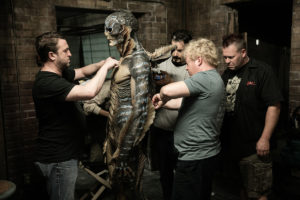My Rating: 9/10
Should I watch this?
If you like good love stories, it will make you really happy. If you don’t like love stories, this film will still make you happy.
It seems a little unfair to do yet another film by Guillermo del Toro, but I love him so it’s okay. Plus, I wanted to do more recent films that I’ve seen, since I’ve mostly been working on throwbacks and films I had a lot to say about but nobody to say it to, except the hubs, who has his own criticisms that far outstretch my own in sophistication and brutality.
The Shape of Water is a love story about a government facility janitor who falls in love with an amphibious creature held prisoner there. If any filmmaker besides Guillermo del Toro (or maybe, MAYBE Tim Burton) was making this film, I think it’d be harder for audiences to accept. Del Toro has built a reputation for himself as being the czar of monsters and macabre, perpetuating delightful enjoyment in the bizarre and hideous. Doug Jones, who plays the amphibious love interest, has a long record of working with del Toro, and is, of course, amazing in this film. The perks of using actual prosthetic costumes and makeup truly pay out in this film, looking so realistic that movies have magic again. The Shape of Water: now without the now-conventional distraction of “is that CGI or what?”

Sally Hawkins and female version of Eddie Redmayne plays Eliza, a mute and delightful character who we fall in love with instantly. The genuine nature of her personality is explained visually and effectively, as we watch her start her day, make her breakfast, masturbate in the tub, and take a sandwich to her best friend and neighbor, Giles. Yes, I said masturbate in the tub, and it’s now my favorite way of introducing a character.
Now that I think of it, this would not have worked nearly as well with a male character. This is particularly awesome because it solidifies the decision to make our protagonist female. Go, del Toro, go!
Her daily life is carefully shown onscreen without much need for explanatory dialogue, a beautiful parallel to her muteness. The natural cues of her everyday life teach us so much about her character, it’s impossible not to cheer for her.

Her friend and coworker Zelda (Octavia Spencer) speaks for Eliza at work and helps her free the Amphibian Man. Their interactions are enjoyable to watch, with Zelda discussing the misdeeds of her husband, and criticizing the way the facility is run. The interaction between the maintenance workers sells the authenticity of every day life.
The most striking point of this film for me, and probably for everyone, was the relationship that is developed between Eliza and the Amphibian Man. Let’s call him Abe, for no reason in particular (winkwink). Their ability to transcend barriers of communication and therefore fall in love were actually believable, despite the reality of their…differences. The support of her friends’ was why she was able to rescue him, and solidified the audience’s acceptance of the unique relationship.

Granted, Giles (Richard Jenkins) initially refused to help her free Abe, but after realizing that she’s all he has in the world, he cooperates. I was worried he would be too reluctant to the point of betrayal, but he becomes thoroughly charming and sweet, even showing careful understanding when Abe eats his cat and scratches his forearm. Scenes like this are unavoidable, I think, when dealing with miscommunication between species.
One of the more interesting character arcs was that of Dr. Robert Hoffstetler, who is actually a Russian spy. Despite his double agent status, Dr. Hoffstetler instead decides to serve his own interests, choosing to help Eliza rescue Abe, and offering his support to her. He is a unique character, and first and foremost a man of science, willing to betray his county and his company for the sake of doing what’s right. He reminds me so much of Dr. Ferreiro from Pan’s Labyrinth, another double-agent who also gives his life for the sake of others.

Strickland, the main threat to everyone’s happiness and sanity, is a terrifying villain. Not only does he display the toxic masculinity so prevalent in 1950’s American culture (or American culture in general), but he has a taste for violence and intimidation. He’s a great example of a villain who is real, hiding behind the “pleasant-ville” coating of his nuclear family. I can believe that men like that existed, and continue to exist, and his creepy approach to Eliza is bone-chilling real. His sinister persona is accentuated by the rotting fingers re-attached to his hand, which had been, uh, removed by Abe early in the film. As the movie progresses, they get blacker and fouler, and the other characters begin to complain of the smell as they realized Strickland’s descent into desperate madness.

This film is successful for all of the reasons above, but mostly for its statement on love. The message is that love has no species, therefore no physical boundaries, which is a thoughtful consideration of what love means. The store is sincere, and from the heart. I thought it was particularly commendable that they really went for it. Not only is this a love story between Amphibian Man and human woman, but they’re going to consummate it. A bold choice, I think, and I’m certain if it hadn’t been done well, people would be dismissing the film instead of praising it. Toeing the line between romance and potential abomination is done masterfully here, and we’re sooooo happy that Abe and Eliza end up together. This film is made so well that we can readily accept the terms of the fantastical relationship developing before our very eyes, despite how impossible it may have seemed in the beginning.
Success:
Solid YES.
Cry Count:
- I don’t know, I kinda teared up off and on throughout the whole thing, so it’s impossible to say how many times, so let’s just say one.

